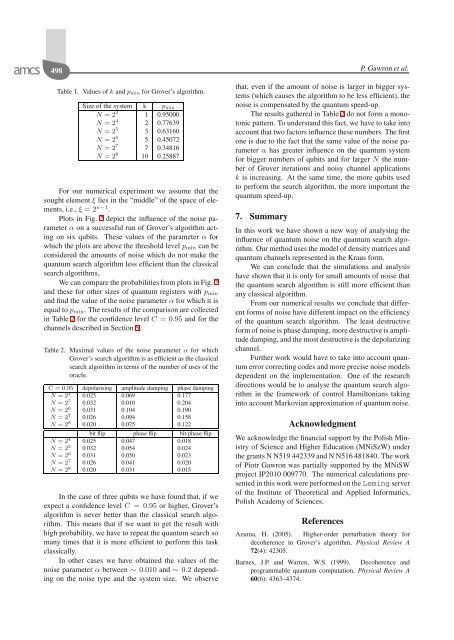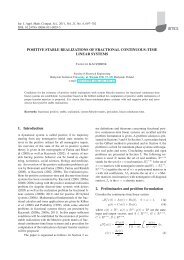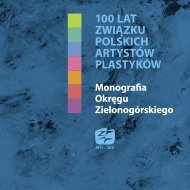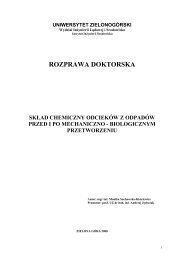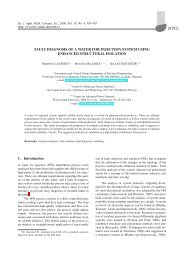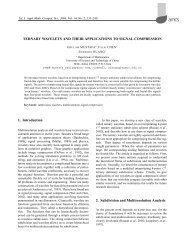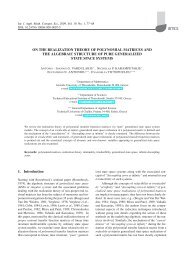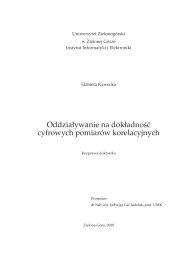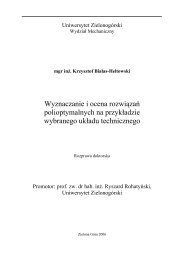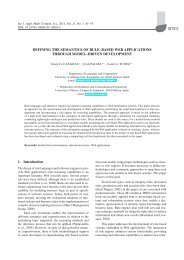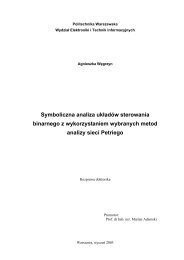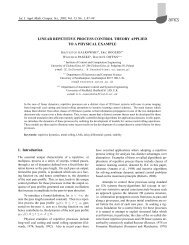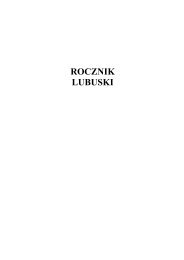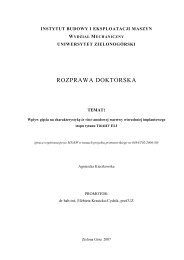NOISE EFFECTS IN THE QUANTUM SEARCH ALGORITHM FROM ...
NOISE EFFECTS IN THE QUANTUM SEARCH ALGORITHM FROM ...
NOISE EFFECTS IN THE QUANTUM SEARCH ALGORITHM FROM ...
You also want an ePaper? Increase the reach of your titles
YUMPU automatically turns print PDFs into web optimized ePapers that Google loves.
498 P. Gawron et al.<br />
Table 1. Values of k and p min for Grover’s algorithm.<br />
Size of the system k p min<br />
N =2 3 1 0.95000<br />
N =2 4 2 0.77639<br />
N =2 5 3 0.63160<br />
N =2 6 5 0.45072<br />
N =2 7 7 0.34816<br />
N =2 8 10 0.25887<br />
For our numerical experiment we assume that the<br />
sought element ξ lies in the “middle” of the space of elements,<br />
i.e., ξ =2 n−1 .<br />
Plots in Fig. 2 depict the influence of the noise parameter<br />
α on a successful run of Grover’s algorithm acting<br />
on six qubits. These values of the parameter α for<br />
which the plots are above the threshold level p min can be<br />
considered the amounts of noise which do not make the<br />
quantum search algorithm less efficient than the classical<br />
search algorithms.<br />
We can compare the probabilities from plots in Fig. 2<br />
and these for other sizes of quantum registers with p min<br />
and find the value of the noise parameter α for which it is<br />
equal to p min . The results of the comparison are collected<br />
in Table 2 for the confidence level C =0.95 and for the<br />
channels described in Section 5.<br />
Table 2. Maximal values of the noise parameter α for which<br />
Grover’s search algorithm is as efficient as the classical<br />
search algorithm in terms of the number of uses of the<br />
oracle.<br />
C =0.95 depolarising amplitude damping phase damping<br />
N =2 4 0.025 0.069 0.177<br />
N =2 5 0.032 0.010 0.204<br />
N =2 6 0.031 0.104 0.190<br />
N =2 7 0.026 0.094 0.158<br />
N =2 8 0.020 0.075 0.122<br />
bit flip phase flip bit-phase flip<br />
N =2 4 0.025 0.047 0.018<br />
N =2 5 0.032 0.054 0.024<br />
N =2 6 0.031 0.050 0.023<br />
N =2 7 0.026 0.041 0.020<br />
N =2 8 0.020 0.031 0.015<br />
In the case of three qubits we have found that, if we<br />
expect a confidence level C =0.95 or higher, Grover’s<br />
algorithm is never better than the classical search algorithm.<br />
This means that if we want to get the result with<br />
high probability, we have to repeat the quantum search so<br />
many times that it is more efficient to perform this task<br />
classically.<br />
In other cases we have obtained the values of the<br />
noise parameter α between ∼ 0.010 and ∼ 0.2 depending<br />
on the noise type and the system size. We observe<br />
that, even if the amount of noise is larger in bigger systems<br />
(which causes the algorithm to be less efficient), the<br />
noise is compensated by the quantum speed-up.<br />
The results gathered in Table 2 do not form a monotonic<br />
pattern. To understand this fact, we have to take into<br />
account that two factors influence these numbers. The first<br />
one is due to the fact that the same value of the noise parameter<br />
α has greater influence on the quantum system<br />
for bigger numbers of qubits and for larger N the number<br />
of Grover iterations and noisy channel applications<br />
k is increasing. At the same time, the more qubits used<br />
to perform the search algorithm, the more important the<br />
quantum speed-up.<br />
7. Summary<br />
In this work we have shown a new way of analysing the<br />
influence of quantum noise on the quantum search algorithm.<br />
Our method uses the model of density matrices and<br />
quantum channels represented in the Kraus form.<br />
We can conclude that the simulations and analysis<br />
have shown that it is only for small amounts of noise that<br />
the quantum search algorithm is still more efficient than<br />
any classical algorithm.<br />
From our numerical results we conclude that different<br />
forms of noise have different impact on the efficiency<br />
of the quantum search algorithm. The least destructive<br />
form of noise is phase damping, more destructive is amplitude<br />
damping, and the most destructive is the depolarizing<br />
channel.<br />
Further work would have to take into account quantum<br />
error correcting codes and more precise noise models<br />
dependent on the implementation. One of the research<br />
directions would be to analyse the quantum search algorithm<br />
in the framework of control Hamiltonians taking<br />
into account Markovian approximation of quantum noise.<br />
Acknowledgment<br />
We acknowledge the financial support by the Polish Ministry<br />
of Science and Higher Education (MNiSzW) under<br />
the grants N N519 442339 and N N516 481840. The work<br />
of Piotr Gawron was partially supported by the MNiSW<br />
project IP2010 009770. The numerical calculations presented<br />
in this work were performed on the Leming server<br />
of the Institute of Theoretical and Applied Informatics,<br />
Polish Academy of Sciences.<br />
References<br />
Azuma, H. (2005). Higher-order perturbation theory for<br />
decoherence in Grover’s algorithm, Physical Review A<br />
72(4): 42305.<br />
Barnes, J.P. and Warren, W.S. (1999). Decoherence and<br />
programmable quantum computation, Physical Review A<br />
60(6): 4363–4374.


